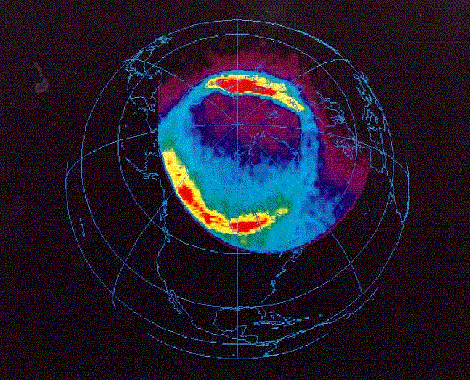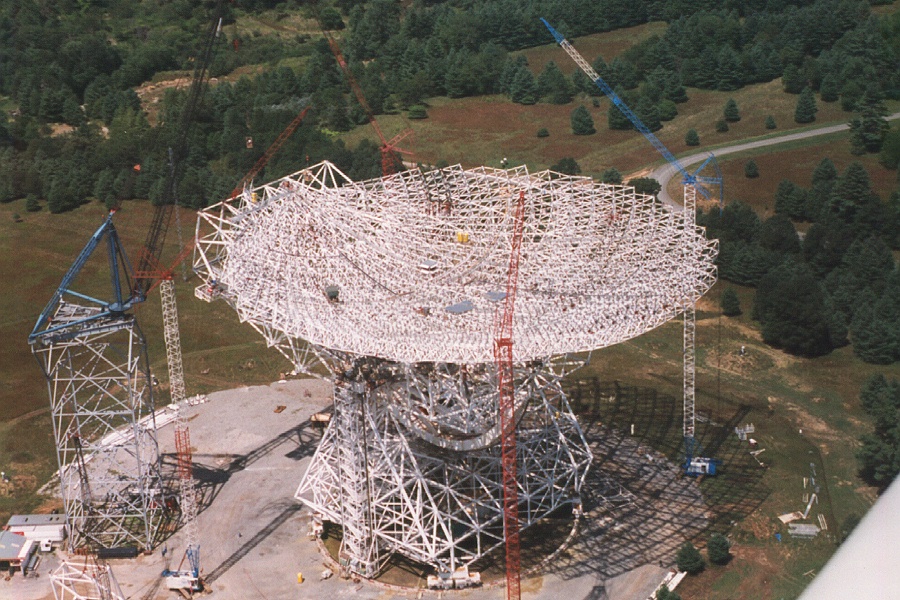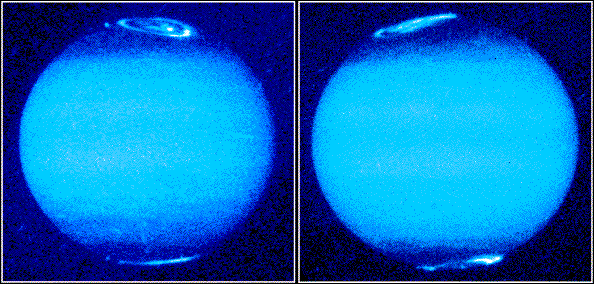Lecture 16 - Earth's Atmosphere (11/5/98)
 Interferometry --- | ---
Earth's Interior
Interferometry --- | ---
Earth's Interior


Reading:
Chapter 4-5, 4-6 (ZG4)
An image of the Aurora Borealis oval from the Polar
Spacecraft (courtesy G.E.Parks UWash, NASA)
 |
Key Question: |
What determines how high in the
atmosphere a particular gas can go?
|
|---|
 |
Key Principle: |
Pressure Scale Height
|
|---|
 |
Key Problem: |
Calculate the scale height of
the atmosphere at sea level.
|
|---|
 |
Key Quote: |
|
|---|
Investigations:
- Atmospheric Composition, Weather and Climate
- What are the relative concentrations of N2, O2, Ar, CO2, Ne,
CH4, and H2O in our atmosphere (at sea level)?
- Which constituents are increasing? Decreasing? Variable?
- What is the latent heat of 1 gram of water at 0 C?
- How much energy does it take to vaporize 1 gram of H20? How
do you get this energy back?
- How does vaporization and condensation of H2O drive weather and
climate on the Earth?
- What might we expect to happen if the mean temperature of the Earth
were to rise even a few degrees? Drop a few degrees?
- Is the doubling of CO2 since pre-industrial values of concern for
our climate? Why?
- How high does the troposphere extend?
- What is the stratosphere? Where is the tropopause
and what are the jet streams?
- What is the significance of the ozone layer and where
is it?
- What is the ionosphere?
- What is the exosphere and what happens to light gases in
there?
- The Magnetosphere
- Where is the Earth's magnetic field generated?
- What is its strength on the surface, and how does it fall off
with radius?
- What causes magnetic reversals? How often do they occur?
- What are the Van Allen Belts and where are they?
- What is the Lorentz force on a charged particle q moving
with velocity v in magnetic field B?
- Why do charged particles "orbit" magnetic field lines?
- Which direction does an electron orbit in a magnetic field? A proton?
What is the radius of the orbit?
- How are charged particles caught in the Van Allen belts?
- Why do electrons drift Eastward in the belts?
- What is the magnetosphere?
- How far toward the Sun is the magnetopause?
- How far away from the Sun does the magnetotail extend?
- What causes aurorae?
- What is the auroral oval as seen from space?
- How do charged particles get to the Earth along the field lines?
- Which planets might be expected to have significant magnetospheres?
- Structure of Our Atmosphere
- How is the weight of a gas column balanced by a pressure gradient?
- What is the ideal gas law?
- Why is the atmospheric pressure per unit area just equal to
the weight of the column of air above it? How does this depend
on the distribution or composition?
- What is the pressure scale height of the atmosphere?
- How might we expect the atmospheric composition to vary with
height?
- What is the pressure at sea level in Pascals? In bars?
In tons/m^2?
- How much ocean depth is this equivalent to?
- What is the pressure at the bottom of the (average) ocean depth of
3000 m?
- What would our atmosphere be like if all the water boiled away?
- How many bars of CO2 are contained in the Earth's crust?
- Is there enough CO2 in the Earth's crust to cause runaway boiling of
the oceans?
Earth's Atmospheric Composition:
| Species | Abundance (%) | Activity |
|---|
| N2 | 78.1 | inert |
| O2 | 20.9 | active (oxidizing) |
| Ar | 0.93 | inert |
| CO2 | 0.034 | greenhouse, increasing |
| Ne | 0.0028 | inert |
| CH4 | 0.0005 | greenhouse (reducing),
increasing |
| H2O | 0.1 - 3 | variable |
More Telescopes and Interferometers

The Green Bank Telescope under construction in West Virginia
as of 19Aug98 (courtesy NRAO)
The Aurora
Some interesting images of the aurora (borealis and australis) can
be found on the Web, particularly on the
Astronomical Picture of the Day website!
Also note that Jupiter has a much larger magnetic field than the
Earth, though it is further from the Sun also. Almost all the gas
giants have substantial magnetospheres and show auroral activity!

Jupiter's aurorae as seen by HST (courtesy STSCI/NASA)
 Prev Lecture ---
Prev Lecture ---
 Next Lecture ---
Next Lecture ---
 Astr11 Index ---
Astr11 Index ---
 Astr11 Home
Astr11 Home
smyers@nrao.edu
Steven T. Myers
 Interferometry --- | ---
Earth's Interior
Interferometry --- | ---
Earth's Interior

 Interferometry --- | ---
Earth's Interior
Interferometry --- | ---
Earth's Interior








 Prev Lecture ---
Prev Lecture ---
 Next Lecture ---
Next Lecture ---
 Astr11 Index ---
Astr11 Index ---
 Astr11 Home
Astr11 Home